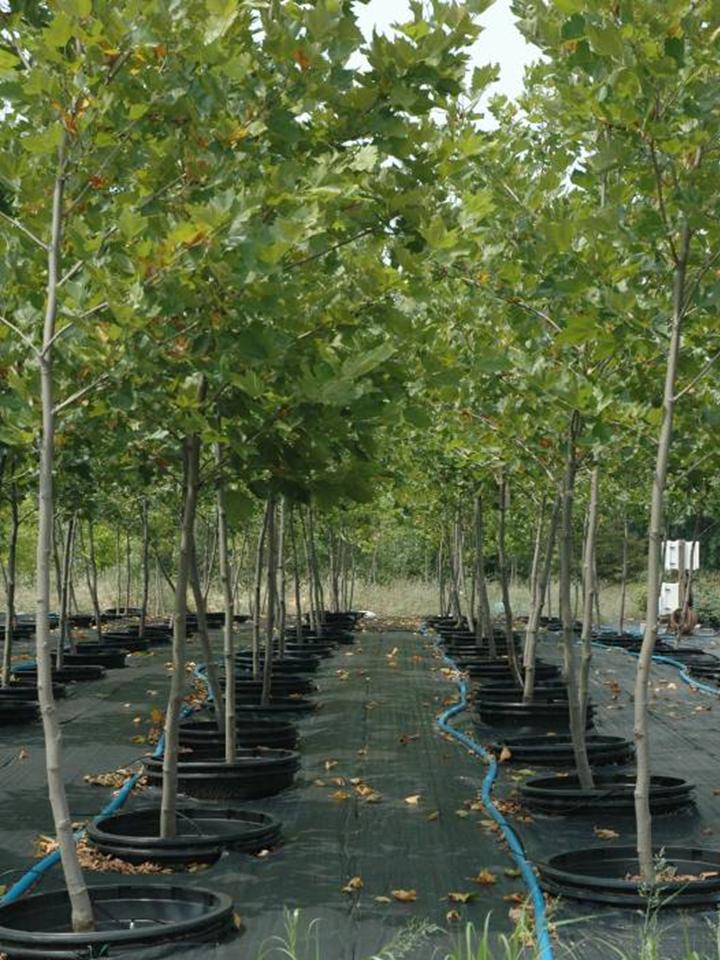Here at the Garden Professors we pride ourselves on being on the cutting edge of technology. In fact, we’re so tech savvy we didn’t even whine when FaceBook foisted a new homepage format on us for no apparent reason. So it’s only fitting that we offer you, Mr. and Ms. Garden Professor Blog reader, an opportunity to participate in the first ever landscape horticulture research project designed by social media.

Here’s the deal. My current research project on water and nutrient management of trees in container production has left us with over 100 ‘Bloodgood’ London planetrees in 25 gallon containers. What I need from you are ideas for a study plan on what to do with the trees next.
Of course, as with any major research project, the first step in the rigorous scientific process is to come up with catchy acronym for the study. I propose “the SOcial MEdia DEsigneD TRansplant ExpErimental Study” or SOME-DED-TREES for short. Needless to say, I am willing to consider alternatives. In any event, we have a unique opportunity to investigate post-transplanting growth, development and physiology of landscape trees.
So here’s what we have: Approximately one hundred, 2” caliper trees, grown in containers in a standard mix of 80% pine bark and 20% peat moss. Trees have been grown for two years in essentially standard nursery culture – daily irrigation and 60 grams of Nitrogen per container. The subject of the original study was fertilizer source; half the trees were fertilized with Osmocote and half received the same amount of nutrients from organic fertilizers. After two years we have not seen any difference in growth or foliar nutrients between the treatments. Nevertheless, I will need to include the prior treatment as a blocking variable to eliminate any potential confounding effects. Beyond that it’s wide open. We could have 6 treatments x 2 blocks x 8 trees = 96 trees. I strongly suspect in the final analysis the block effect will be non-significant and we can consider there to be 16 replicates, but life is full of surprises.
So, what tree establishment or tree care question is burning a hole in your brain? “Shaving” or “butterflying” container rootballs? Fertilizing at time of transplant? The latest biostimulant? Crown thinning at time of transplant? Frequency of post-planting irrigation? Width of the planting hole – how wide is wide enough? Send me your suggestions and we will set up a poll to vote for the top choices.
I have some burning questions:
1. Difference b/t synthetic and organic fertilized containers in presence of arbuscular mycorrhizae?
2. Drought tolerance of those containers with and without VAM?
3. Identify those specimens (if any) where VAM are present in soil and record, when they are transplanted, variations in recovery rates between those with and without AM.
4. Repeat your experiment, but this time, soil samples inoculated with VAM. Measure pre- and post-experiment the amount of VAM left after all that synthetic fertilizing is finished.
Thank you!
How about comparing the standard planting & mulching method (no fertilisers, soil additives etc) against some of the miracle products we see in nurseries every day. Do they actually improve tree establishment? You know the miracle products; stuff called things like “PowerGrow” and “Ro
cketOff”, they promise so much but do they deliver?
the biggest problem I see everyday as an arborist is root ball issues that result from a pot-bound tree getting planted according to current standard instructions (pull plant out of pot, drop in hole, backfill). Shaving rootballs is an interesting remedy, as is Bonnie Appleton’s approach of dismantling rootballs completely to untangle roots.
I’ve also seen research that suggests it’s preferable NOT to mulch the rootball of a new transplant (still mulching the area beyond the root ball)
I really believe nursery practices need to change so we get fewer of these knotted messes to deal with, but it seems unlikely that most of us wills ee that happen any time soon. We need to develop better planting techniques to address this problem or our future urban forests will be composed primarily of young transplants that continually must be replaced. We know 10 2-inch trees do not come close to providing the benefits of one 20-inch tree, but we are virtually guaranteeing we will not see many more 20-inch trees in the future with current practices.
One of the more common issues I see on residential landscapes are trees that are planted too deep or ones that are planted in narrow raised beds. How about simulating these conditions?
Would it be unrealistic to compare planting bare-root vs. regular untouched container grown vs. trimming roots in one or more different ways? I’d be interested in seeing if there were different growth rates/patterns. And I’m also interested in different mulches used… I wonder if just covering w/leaves chopped vs. whole vs. colored hardwood mulch vs. pinebark would have different growth of both the root & tree. Wish I had more knowledge of studies that have been done.
How about newly planted trees, tree rings vs properly planted trees. have 1/3 planted property, 1/3 planted properly then install a tree ring, and 1/3 planted after a tree ring. You can also have different dpths of the tree ring over newly planted trees.
Potential opportunity to get more data on the “bare root” vs B&B or container plantings you guys debated before.
https://sharepoint.cahnrs.wsu.edu/blogs/urbanhort/archive/2009/09/03/bare-root-trees.aspx
Call it the BAROOTGARPRO study.